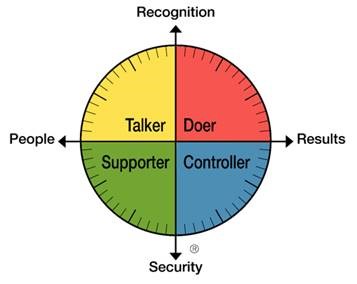Aligning Customer Communication Styles With Your Own

The Behavioral Styles® model is an easy-to-use tool for assessing the behavioral characteristics that fall within four distinct customer communication styles: Talker, Doer, Controller and Supporter.
Does communication style matter when it comes to sales? More than you might expect. Studies show that over 80% of customer dissatisfaction is rooted in emotional issues rather than intellectual ones. Features and benefits matter, but trusted relationships, built on strong emotional bonds, are what really make the difference. And those emotional factors are often rooted in how effectively a salesperson or service rep is able to understand customer communication styles and connect with the customer right out of the gate.
How Communication Styles Set The Tone For Customer Relationships
A lot of selling and communication happens during the first few seconds of contact with the customer. Feelings and perceptions are quickly formed and can become lasting ones. The challenge is that sometimes these messages don’t come across as intended, because each of us views life through different-colored lenses. Our experiences, education and acquired perceptions cause us to think in various patterns, and as a result, two people can view the same information and interpret it in entirely different ways. What seems to-the-point and efficient to you might be viewed as cold and abrupt to someone else. You may pride yourself in your quick decision-making and eagerness to jump in and solve problems, but your customer could feel like they’re being steamrolled.
Successful sales and service professionals focus on understanding these differences in communication style as an important first step toward making emotional connections with their customers. The words people use, tone of voice, cadence, gestures and facial expressions can all tip us off to some of these differences, but the Behavior Styles Model, which categorizes behavioral characteristics within four distinct communication styles, is a great tool for applying this in practice. It provides a common framework and, along with the Behavior Styles assessment, gives us insights about what different people care about, what motivates them and how they prefer to interact.
Once you know your own natural style and how it interacts with others’, you can then adjust your thinking and responses to be more customer-focused and communicate most effectively for that person’s needs. The more you practice, the more you’ll be able to pick up on these differences and relate to your customers on a deeper, more meaningful level.
How To Identify Which Of the 4 Communication Styles Apply To Your Customer
While sales and service professionals can take the assessment to confirm what their own style is, they can also learn how to pick up clues about their customers’ communication styles to quickly establish rapport, understand their issues and meet their needs — both on an emotional and an intellectual level.
Here are some of those clues to look for:
- Doers show high energy, confidence and authority. They want you to notice them for their power and achievement. They can sometimes appear flashy or demanding.
- Controllers are logical, no-nonsense people who value accuracy, efficiency and organization. They want you to listen to and thoroughly understand them. They might appear overly critical at first.
- Supporters are steady, stable, salt-of-the-earth people. They value security and safety, and they carefully avoid risks. They’ll appear compliant and non-assertive.
- Talkers are affable, friendly, social people. They want you to be their friend and show interest in them, their activities and their families. They’ll be easy to approach as long as you allow them to do most of the talking.
Communication Tips for Creating Emotionally Satisfied Customers
Since emotionally satisfied customers are the ones who will be willing to buy multiple products, pay a premium for your offerings and refer your organization to other people, it’s important that your team knows how to create strong relationships.
Using the Behavior Styles as a framework, here are some relationship-building tips that will ensure your sales and service professionals are communicating in a way that’s customer-focused for each individual customer:
Doers:
- Get to the point, but avoid telling the person what they want to hear just because they expect an immediate answer.
- Demonstrate an ability to meet needs fairly quickly.
Controllers:
- Be thorough, provide documentation and use fact-based communications.
- Validate the potential success of a solution by providing a rationale for how/why it will work.
Supporters:
- Establish credibility and earn trust.
- Be sincere and thorough when describing all aspects of the solution.
- Check before assuming the customer is committed to the solution.
Talkers:
- Engage in conversation while always keeping them on task and moving toward a workable solution.
- Keep promises while working to fulfill wants/needs.
Tips For Creating Satisfied Customers With Each Of The 4 Communication Styles
Since emotionally satisfied customers are the ones who will be willing to buy multiple products, pay a premium for your offerings and refer your organization to other people, it’s important that your team knows how to create strong relationships.
Using the Behavior Styles as a framework, here are some relationship-building tips that will ensure your sales and service professionals are communicating in a way that’s customer-focused for each individual customer:
Communicating With The Doer Communication Style:
- Get to the point, but avoid telling the person what they want to hear just because they expect an immediate answer.
- Demonstrate an ability to meet needs fairly quickly.
Communicating With The Controller Communication Style:
- Be thorough, provide documentation and use fact-based communications.
- Validate the potential success of a solution by providing a rationale for how/why it will work.
Communicating With The Supporter Communication Style:
- Establish credibility and earn trust.
- Be sincere and thorough when describing all aspects of the solution.
- Check before assuming the customer is committed to the solution.
Communicating With The Talker Communication Style:
- Engage in conversation while always keeping them on task and moving toward a workable solution.
- Keep promises while working to fulfill wants/needs.
Learn more about the different Behavior Styles and the role increasing communication style effectiveness can have on team productivity.

Master Facilitator
Related Blog Posts



